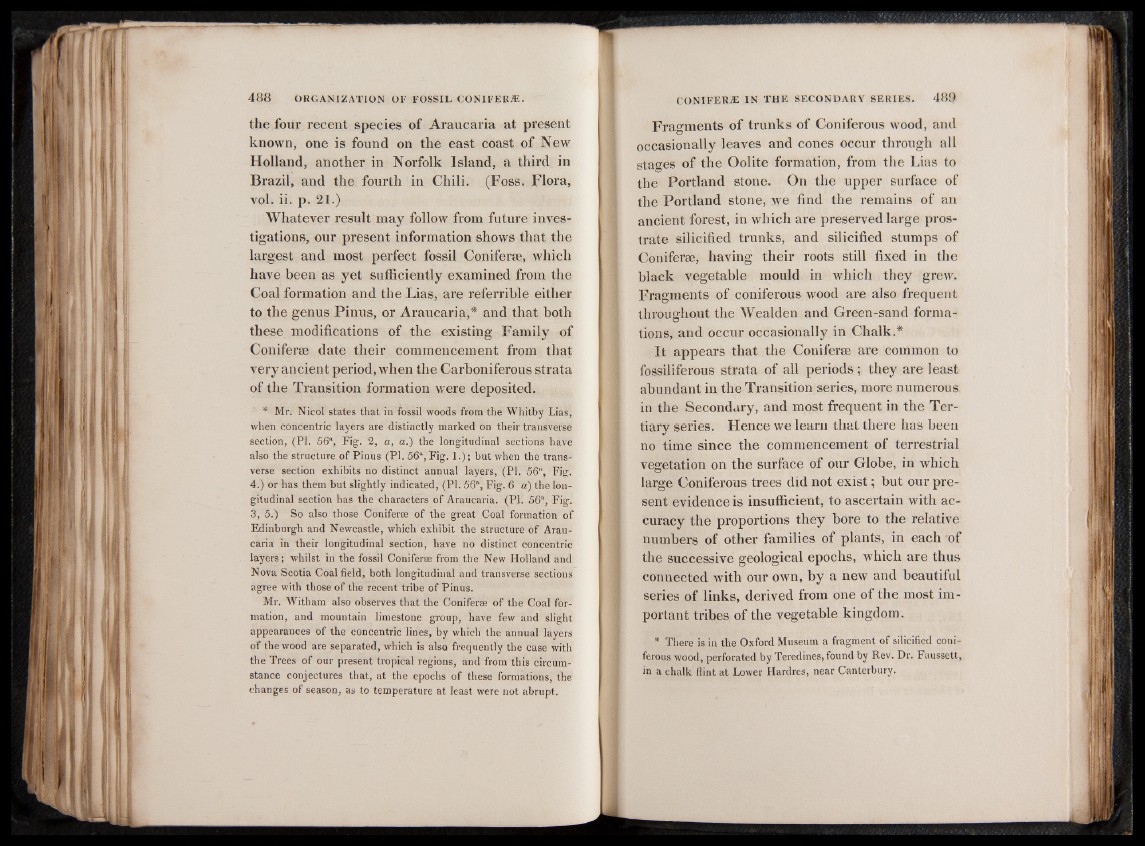
the four recent species of Araucaria at present
known, one is found on the east coast of New
Holland, another in Norfolk Island, a third in
Brazil, and the fourth in Chili. (Foss. Flora,
vol. ii. p. 21.)
Whatever result may follow from future investigations,
our present information shows that the
largest and most perfect fossil Coniferæ, which
have been as yet sufficiently examined from the
Coal formation and the Lias, are referrible either
to the genus Pinus, or Araucaria,* and that both
these modifications of the existing Family of
Coniferæ date their commencement from that
very ancient period, when the Carboniferous strata
of the Transition formation were deposited.
* Mr. Nicol states that in fossil woods from the Whitby Lias,
when concentric layers are distinctly marked on their transverse
section, (PL 56% Fig. 2, a, a.) the longitudinal sections have
also the structure of Pinus (PI. 56% Fig. 1.); but when the transverse
section exhibits no distinct annual layers, (PI. 56% Fig.
4.) or has them but slightly indicated, (PI. 56% Fig. 6 a) the longitudinal
section has the characters of Araucaria. (PI. 56% Fig.
3, 5.) So also those Coniferæ of the great Coal formation of
Edinburgh and Newcastle, which exhibit the structure of Araucaria
in their longitudinal section, have no distinct concentric
layers; whilst in the fossil Coniferæ from the New Holland and
Nova Scotia Coal field, both longitudinal and transverse sections
agree with those of the recent tribe of Pinus.
Mr. Witham also observes that the Coniferæ of the Coal formation,
and mountain limestone group, have few and slight
appearances of the concentric lines, by which the annual layers
of the wood are separated, which is also frequently the case with
the Trees of our present tropical regions, and from this circumstance
conjectures that, at the epochs of these formations, the
changes of season, as to temperature at least were not abrupt.
Fragments of trunks of Coniferous wood, and
occasionally leaves and cones occur through all
stages of the Oolite formation, from the Lias to
the Portland stone. On the upper surface of
the Portland stone, we find the remains of an
ancient forest, in which are preserved large prostrate
silicified trunks, and silicified stumps of
Coniferae, having their roots still fixed in the
black vegetable mould in which they grew.
Fragments of coniferous wood are also frequent
throughout the Wealden and Green-sand formations,
and occur occasionally in Chalk.*
It appears that the Coniferae are common to
fossiliferous strata of all periods ; they are least
abundant in the Transition series, more numerous
in the Secondary, and most frequent in the Tertiary
series. Hence we learn that there has been
no time since the commencement of terrestrial
vegetation on the surface of our Globe, in which
large Coniferous trees did not exist; but our present
evidence is insufficient, to ascertain with accuracy
the proportions they bore to the relative
numbers of other families of plants, in each of
the successive geological epochs, which are thus
connected with our own, by a new and beautiful
series of links, derived from one of the most important
tribes of the vegetable kingdom.
* There is in the Oxford Museum a fragment of silicified coniferous
wood, perforated by Teredines, found by Rev. Dr. Faussett,
in a chalk flint at Lower Hardres, near Canterbury.